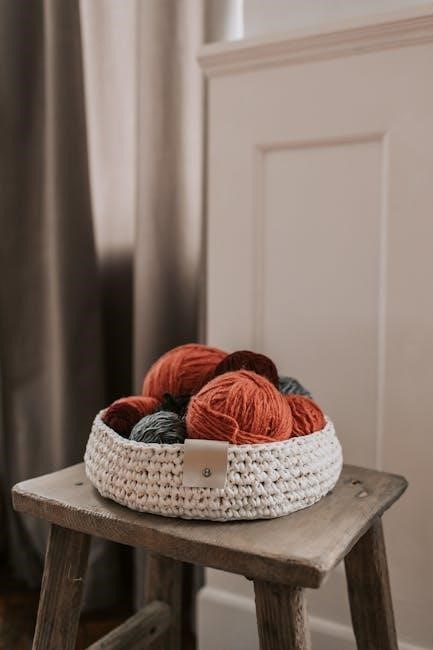Knitting abbreviations are essential for streamlining patterns, making them easier to read and follow. They represent common stitches and techniques, ensuring clarity and efficiency. Downloadable PDF guides offer comprehensive lists of these abbreviations, helping knitters of all skill levels master their craft. Understanding these shorthand terms is key to successful knitting projects, whether you’re a beginner or an experienced crafter. These resources are invaluable for quick reference, ensuring your knitting journey remains seamless and enjoyable.

What Are Knitting Abbreviations?
Knitting abbreviations are shorthand terms used in patterns to represent common stitches, techniques, and instructions. They simplify complex steps, making patterns more concise and easier to follow. For example, “K” stands for “knit,” “P” for “purl,” and “BO” for “bind off.” These abbreviations are universal, allowing designers to communicate clearly across languages and skill levels. They are especially useful for beginners, as they provide a quick reference guide to mastering essential stitches and techniques. Printable PDF guides are widely available, offering comprehensive lists of these abbreviations for easy access and learning.
Why Are Knitting Abbreviations Important?
Knitting abbreviations are crucial for efficient pattern writing and readability. They save space, reduce repetition, and ensure clarity, making complex instructions manageable. By standardizing terms, abbreviations prevent confusion and errors, especially for beginners. Printable PDF guides compile these shorthand terms, offering a handy resource for quick reference. This consistency allows knitters to focus on the creative process, ensuring projects are completed accurately and enjoyably. Abbreviations are a cornerstone of knitting, enabling seamless communication between designers and crafters worldwide.

Common Knitting Abbreviations
Common knitting abbreviations simplify patterns, ensuring clarity and efficiency. Terms like alt, beg, and BO are standard, with comprehensive guides available in downloadable PDFs for easy reference.
Basic Knitting Terms (A-F)
Understanding basic knitting terms from A-F is crucial for mastering patterns. Alt stands for alternate, while beg refers to the beginning of a project. Bet indicates actions between specific stitches. BO means bind off, securing the final stitches. CA and CB denote color A and color B, essential for multicolor projects. CC stands for contrasting color, adding visual interest. Other terms like ch (chain) and cn (cable needle) are fundamental. These abbreviations form the foundation of knitting vocabulary, ensuring clarity and precision in patterns. Printable PDF guides offer convenient access to these definitions, aiding knitters in their creative journey.
Stitch Patterns and Techniques
Stitch patterns and techniques are vital in knitting, with abbreviations simplifying complex instructions. Common terms include K for knit, P for purl, and K2tog for knit two together. Techniques like slip marker (SM) and place marker (PM) help manage complex patterns. C4B and C4F denote cable stitches, while M1R and M1L refer to making stitches. Understanding these abbreviations ensures precise execution of stitches, enhancing the overall quality of knitting projects. Printable PDF guides provide detailed explanations, making it easier to master various stitch patterns and techniques for both beginners and experienced knitters.

Specialized Knitting Abbreviations
Specialized abbreviations include C4B (cable 4 back) and C4F (cable 4 front) for intricate cable patterns. Techniques like M1R (make one right) and M1L (make one left) create stitches. These terms, found in PDF guides, enhance advanced knitting projects with precision and detail, ensuring complex designs are executed flawlessly.
Cables and Twist Stitches
Cables and twist stitches are popular techniques in knitting, often requiring specific abbreviations. C4B stands for “cable 4 back,” while C4F means “cable 4 front.” These terms guide how stitches are crossed. Twist stitches, like M1R (make one right) and M1L (make one left), create subtle texture. PDF guides detail these abbreviations, ensuring clarity for intricate patterns. Understanding these terms is crucial for executing advanced designs, as they dictate stitch orientation and placement. Proper use of cable and twist abbreviations enhances the visual appeal of knitted fabrics, making them essential for skilled knitters seeking precision and creativity in their work.
Increases and Decreases
In knitting, increases and decreases shape the fabric and create texture. Common abbreviations include KFB (knit front and back) for increases and K2tog (knit two together) for decreases. M1R (make one right) and M1L (make one left) add stitches subtly. These terms guide pattern shaping, ensuring proper fit and design. PDF guides detail each abbreviation, helping knitters master techniques like raglan sleeves or fitted garments. Understanding increases and decreases is vital for achieving desired textures and silhouettes in knitting projects, making them indispensable skills for every knitter.

How to Use Knitting Abbreviations

Mastering knitting abbreviations enhances pattern readability and efficiency. Always refer to a downloadable PDF guide for quick reference. Understanding terms like KFB (knit front and back) and K2tog (knit two together) ensures accurate stitching. Regular practice helps knitters of all levels decode patterns seamlessly, making every project a success.
Mastering Abbreviations for Beginners

Mastering knitting abbreviations as a beginner is essential for decoding patterns effectively. Start by familiarizing yourself with basic terms like K (knit), P (purl), and BO (bind off). Downloadable PDF guides provide comprehensive lists, making it easy to reference while working on projects. Practice by completing simple projects that use common abbreviations, gradually building your confidence. Keeping a printed or digital copy handy ensures quick access, allowing you to focus on your stitches without interruption. Over time, these abbreviations will become second nature, enhancing your knitting experience and paving the way for more complex designs.
Avoiding Common Mistakes
Avoiding common mistakes when using knitting abbreviations requires careful attention to detail. Always double-check the meaning of each abbreviation before starting your project, as misinterpretation can lead to errors. Mistakes like confusing K2tog (knit two together) with KFB (knit front and back) can alter the fabric of your knitting. To prevent this, keep a printable PDF guide or digital reference handy for quick clarification. Practice working through each stitch step-by-step, and don’t hesitate to refer back to your guide when unsure. By staying organized and vigilant, you can avoid frustrating errors and ensure your project turns out as intended.
Resources for Knitting Abbreviations
Downloadable PDF guides and online libraries provide comprehensive lists of knitting abbreviations, making it easy to reference techniques and stitches. These resources are invaluable for knitters of all levels.
Downloadable PDF Guides
Downloadable PDF guides are excellent resources for knitters, offering comprehensive lists of abbreviations in an organized format. These guides often include definitions and examples, making them indispensable for quick reference. Many websites provide free PDFs that cover basic and specialized terms, ensuring that both beginners and experienced knitters can easily access the information they need. By keeping a PDF guide handy, knitters can quickly look up unfamiliar abbreviations, saving time and reducing mistakes. These guides are particularly useful for working on complex patterns or learning new techniques. They are a must-have tool for any knitting project.
Online Libraries and Tutorials
Online libraries and tutorials are invaluable for mastering knitting abbreviations, offering interactive guides and video demonstrations. Websites like Moogly and The Spruce Crafts provide detailed explanations and visual aids, making complex techniques easier to understand. Many platforms feature searchable databases of abbreviations, allowing knitters to quickly find specific terms. Tutorials often include step-by-step instructions, perfect for visual learners. These resources are accessible anytime, making them ideal for knitters of all skill levels. They also frequently update with new content, ensuring users stay informed about the latest techniques and terminology in knitting.
- Video tutorials for visual learners
- Interactive guides for practice
- Comprehensive databases of abbreviations
- Accessible on-demand learning
Mastering knitting abbreviations enhances efficiency and creativity in your projects. With resources like PDF guides and online tutorials, knitters of all levels can easily access and understand these essential terms.
Final Tips for Working with Abbreviations
Always refer to a knitting abbreviations PDF guide for quick reference. Keep it handy while working on projects to avoid confusion. Double-check abbreviations before starting a pattern to ensure accuracy. Familiarize yourself with common terms like knit (K) and purl (P) to enhance efficiency. Use stitch markers to track your progress and count stitches regularly. Update your guide with new abbreviations as you discover them. Practice makes perfect—don’t hesitate to explore online libraries and tutorials for additional support. Happy knitting!
Staying Organized with Knitting Patterns
Staying organized enhances your knitting experience, especially with complex patterns. Use a knitting abbreviations PDF to keep all terms in one place. Print and bind the guide for easy access. Label your yarn, needles, and patterns clearly. Maintain a project journal to track progress and notes. Organize supplies in a dedicated knitting kit. Use digital tools or apps to store and reference patterns. A tidy workspace and clear references ensure efficiency and reduce errors. Stay methodical and enjoy the creative process without unnecessary stress.